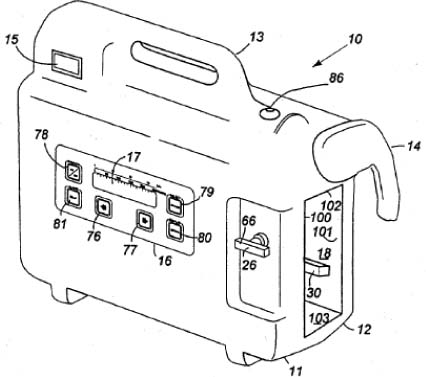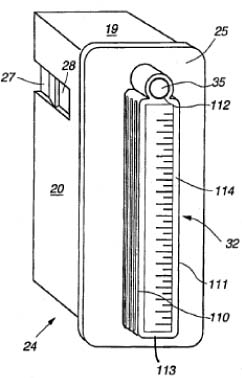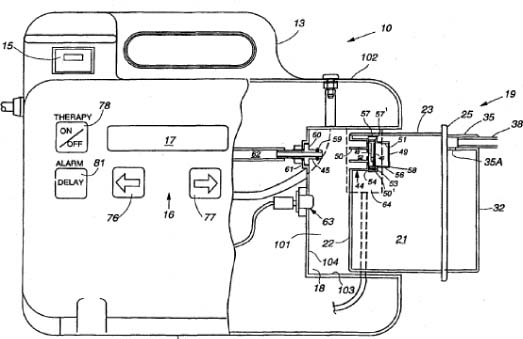KCI Licensing Inc. and iothers v Smith & Nephew Plc and Others
| Jurisdiction | England & Wales |
| Judge | Lord Justice Jacob |
| Judgment Date | 18 November 2010 |
| Neutral Citation | [2010] EWCA Civ 1260 |
| Docket Number | Case No: A3/2010/1929 & 1993 |
| Court | Court of Appeal (Civil Division) |
| Date | 18 November 2010 |
[2010] EWCA Civ 1260
The Hon Mr Justice Arnold
Before: The Rt Hon Lord Justice Longmore
The Rt Hon Lord Justice Jacob
and
The Hon Mr Justice Kitchin
Case No: A3/2010/1929 & 1993
IN THE HIGH COURT OF JUSTICE
COURT OF APPEAL (CIVIL DIVISION)
ON APPEAL FROM THE HIGH COURT OF JUSTICE
CHANCERY DIVISION (PATENTS COURT)
Michael Tappin QC and Henry Ward (instructed by Olswang LLP) for the Claimants/Respondents
James Mellor QC and Andrew Lykiardopoulos (instructed by Bristows) for the Defendants/Appellants
Hearing dates: 18/19 October 2010
Lord Justice Jacob:
This is the judgment of the Court.
By the judgment under appeal, [2010] EWHC 1487 (Pat), Arnold J held that S&N (as we will call all the defendants) have infringed KCI's (as we call the claimant patentees) EP (UK) patents Nos. 0 777 504 (‘504) and 0 853 950 (‘950) (collectively “the Patents”). The Patents are for apparatus to be used for negative pressure wound therapy (“NPWT”). ‘950 is a divisional of ‘504. They have the same priority date (22.8.1994) and virtually the same specification.
More specifically the judge held:
i) the Patents are entitled to the priority date claimed;
ii) S&N's attacks on the validity of claim 5 of ‘504 and claims 7 and 8 of ‘950 failed;
iii) S&N's GO and EZ pumps and canisters fall within the scope of the relevant parts of claim 5 of ‘504 and claims 7 and 8 of ‘950;
iv) S&N have infringed claim 5 of ‘504 pursuant to section 60(2) of the Patents Act 1977 by sales of the GO pumps and canisters;
v) S&N have infringed claims 7 and 8 of ‘950 pursuant to section 60(2) of the Act by sales of the EZ canisters, but not by sales of the GO canisters.
The judge gave permission to appeal on all these points save for the obviousness points. S&N have not pursued an appeal on priority and, at a late stage, abandoned their appeal against the finding of infringement in respect of the EZ canisters.
The issues we have to decide are:
i) Does the GO system infringe claim 5 of ‘504 and, in particular, does it have:
a) “means for detecting when the canister is substantially filled with liquid and generating a signal which causes the pump to be deactivated”, and
b) “a guide for aligning the container in a recess in the housing such that the suction port is connected to the pump”?
ii) Were sales of the GO canisters intended to put the inventions of claims 7 and 8 of ‘950 into effect within the meaning of section 60(2)?
iii) In relation to obviousness:
a) whether it was obvious in 1994 to use reticulated foam as the dressing for NPWT—the invention of claim 5 of ‘504 and claim 8 of ‘950. S&N sought permission to appeal.
b) whether it was obvious in 1994 to put a gel-forming substance in the canister to prevent spillage of liquid – the invention of claim 7 of ‘950. Again, S&N sought permission to appeal.
Applicable legal principles
It is not contended that the judge misstated the law. He accurately set out the law as to common general knowledge (“cgk”) at [105]-[112]. It is worth re-repeating what he said about information which is available but not immediately in the head of the notional skilled person:
[112] It follows that, even if information is neither disclosed by a specific item of prior art nor common general knowledge, it may nevertheless be taken into account as part of a case of obviousness if it is proved that the skilled person faced with the problem to which the patent is addressed would acquire that information as a matter of routine. For example, if the problem is how to formulate a particular pharmaceutical substance for administration to patients, then it may be shown that the skilled formulator would as a matter of routine start by ascertaining certain physical and chemical properties of that substance (e.g. its aqueous solubility) from the literature or by routine testing. If so, it is legitimate to take that information into account when assessing the obviousness of a particular formulation. But that is because it is obvious for the skilled person to obtain the information, not because it is common general knowledge.
As to obviousness, the judge stated the principles at [139]-[140]. Neither side quarrels with that. As to claim construction, again there is no dispute as to the principles, the judge having properly referred to them at [170]-[171].
All we need to add are two matters concerning the approach on appeal, both of which were also uncontroversial. First there is the well-known approach of the Court of Appeal as to appeals on obviousness, the so-called Biogen principle, namely that:
Where the application of a legal standard such as negligence or obviousness involves no question of principle but is simply a matter of degree, an appellate court should be very cautious in differing from the judge's evaluation per Lord Hoffmann in Biogen v Medeva [1997] RPC 1 at p.45
Secondly there is the approach of the Court of Appeal to questions of fact. The Court will only interfere with a finding of fact by a judge where there was no proper material upon which the finding could be based – the legal term for this is “perverse” although in this context the word does not carry with it the overtone of personal criticism which it is apt to carry in other contexts.
The skilled team, prior art and common general knowledge
The skilled team to which the Patents are addressed includes a clinician and a design engineer but the team would be led by the clinician. The clinical evidence was given by KCI's expert, Dr Téot, whose first language was not English. The engineering evidence was given by Mr Wood for S&N and Mr Buckley for KCI. S&N chose not to call their own clinical expert, Dr Gordon.
The Patents present the inventions as improvements over the disclosure of a prior published patent application called “Argenta” (WO 93/09727). The judge sets out material passages of this at [8]-[14]. The basic idea is to treat large open wounds by the use of a screen over the wound, covering this with a larger material such as a flexible polymer sheet so to provide a seal and applying a vacuum. The vacuum increases the blood flow which speeds up healing.
Argenta says this about the screen which is applied to the wound:
“The screen means is placed over substantially the expanse of the wound to prevent its overgrowth. The size and configuration of the screen can be adjusted to fit the individual wound. It can be formed from a variety of porous semi-rigid materials. The material must be sufficiently porous to allow oxygen to reach the wound, and sufficiently rigid to prevent wound overgrowth. Most preferred is the use of an open-cell polymer foam, which permits direct connection of the screen means to the vacuum means through a flexible hose inserted into the foam. Such foam can vary in thickness and rigidity, although it is preferred that a spongy material be used for the patient's comfort if the patient must lay [sic] upon the device during its operation. It can also be perforated to reduce its weight. Another embodiment comprises a section of honeycombed polyethylene sheet cut to the shape of the wound.” (8 3–19).
As to the vacuum means, all Argenta says is this:
“Suitable vacuum means includes any suction pump capable of providing at least 0.1 pound suction to the wound, and preferably up to 3 pounds suction, and most preferably up to 14 pounds suction, and a flexible hose that leads from the pump to a point within the pressurized volume created by the sealing means. The pump can be any ordinary suction pump suitable for medical purposes that is capable of providing the neces[s]ary suction. The dimension [sic] of the tubing are limited only by the pump's ability to provide the suction level neede[d] for operation. A 1/4 inch diameter tube has proven suitable. The vacuum means may operate substantially continuously, or may operate cyclically with alternate periods of application and nonapplication of pressure to the wound.” (8 36-9 13).
Patent ‘504
The judge sets out all the material portions of this at [15]-[32]. Because the issues of construction and infringement involve no question of principle we will not lengthen this judgment by setting them out all over again in detail. We will confine ourselves to the figures and passages relevant to the issues as we get to them.
In summary, the main idea of the patent as set out in claim 1 is to use a disposable canister and tubing to collect exudate from the wound. This prevents any contamination of the pump. KCI do not resist the contention that that idea is old or obvious so that the main claims of the patents are not valid. But, say KCI, certain of the sub-claims of the patents are valid and infringed. In particular we are concerned with claim 5 of ‘504 and, in due course, claims 7 and 8 of ‘950.
The specific embodiment of the pump apparatus looks like this:

The removable canister slides into the aperture on the right.
The canister looks like this:

One can see the canister fitted into the chamber in fig. 6:

It does not go wholly in – part sticks out.
The specification, before it gets to the specific embodiment, says this about the canister and body:
“In accordance with the present invention, there is provided a therapeutic...
To continue reading
Request your trial-
Actavis Group Ptc EHF and Another v Eli Lilly and Company
...Licensing v Smith and Nephew [2010] EWHC 1487 (Pat); [2010] FSR 31 at [105]–[115], which were approved by the Court of Appeal at [2010] EWCA Civ 1260; [2011] FSR 8 at [6]. As would be expected, much of the following was common ground between the experts. There were, however, some import......
-
Glaxosmithkline UK Ltd v Wyeth Holdings Llc
...in KCI Licensing v Smith & Nephew [201] EWHC 1487 (Pat); [2010] FSR 31 at [105]–[115], which was approved by the Court of Appeal at [2010] EWCA Civ 1260; [2011] FSR 8 at [6]. 29 GSK relied on the following passage from the judgment of Sales J. in Teva v Astrazeneca (asthma) [2014] EWHC 287......
-
Regeneron Pharmaceuticals Inc. v Kymab Ltd and Another
...out by Arnold J in KCI Licensing Inc v Smith & Nephew Plc [2010] FSR 31 at [105]–[115], which were approved by the Court of Appeal at [2011] FSR 8 at [6]. There are a significant number of disputes, and when considering each issue I will identify the area of the case to which it is releva......
-
Illumina, Inc. and Others (Claimants to case no HC-2015-001175) Illumina, Inc. and Another (Claimants in case no HP-2015-000047) v Premaitha Health Plc and Another (Defendants in case nos HC-2015-001175 HP-2015-000047)
...in KCI Licensing v Smith & Nephew [2010] EWHC 1487 (Pat); [2010] FSR 31 at [105]–[115], which was approved by the Court of Appeal at [2010] EWCA Civ 1260; [2011] FSR 8 at [6]. 27 The parties emphasised that much of the common general knowledge was agreed. However, it did not prove easy to ......
-
The Basic Of Patent Law - Revocation, Non-Infringement And Clearing The Way
...are engaged in the particular art, or as the technical background of the person skilled in the art (Smith & Nephew v KCI Licensing [2010] EWCA Civ 1260). The common general knowledge may include material which the skilled addressee knows to be available online and which is generally acc......
-
IP Snapshot - December 2010
...to be considered and evidence which could be served. For the full text of the decision, click here KCI Licensing v Smith & Nephew [2010] EWCA Civ 1260 The Court of Appeal has allowed some of the grounds of appeal from the High Court decision on the infringement and validity of two paten......
-
Warner-Lambert v Actavis: Supreme Court Considers Medical Use Claims
...paragraphs [63], [86], [123] and [129] of the Supreme Court judgment. KCI Licensing Inc and others v Smith and Nephew plc and others [2010] EWCA Civ 1260 The content of this article is intended to provide a general guide to the subject matter. Specialist advice should be sought about your s......
-
Management and Enforcement
...by the equitable assignor: KCI Licensing Inc. v. Smith & Nephew PLC , [2010] EWHC 1487 at [69]–[71] (Pat. Ct.), rev’d on other grounds [2010] EWCA Civ 1260 [ KCI ]. 68 Masterfile Corp. v. World Internett Corp. (2001), 16 C.P.R. (4th) 139 (Fed. T.D.) [ Masterfile ]. 69 Pecore v. Pecore , [......

